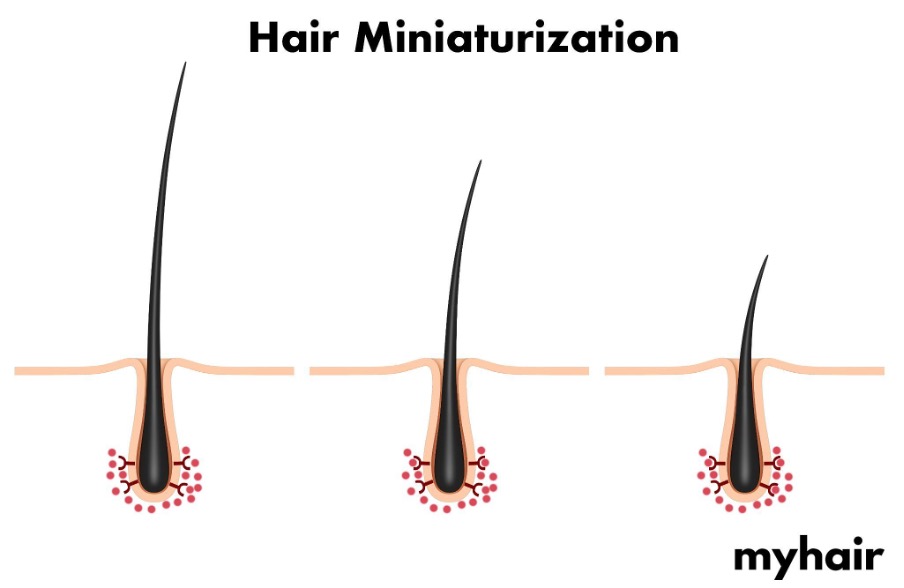Thinning hair can be frustrating: It can exaggerate the appearance of hair loss and balding, even when you still have a substantial amount of hair. This unpleasant side effect can be counteracted in two ways. You can try to increase the diameter of your hairs in order to literally make these hairs thicker, or you can try to increase your hair density.
Thinning hair has many causes
Hair thinning, unpleasant as it may be, is a natural part of aging. According to a study in the International Journal of Cosmetic Science, the diameter of your hairs gets smaller as you age. Getting older isn’t the only thing that causes your hairs to shrink, though. People who smoke and who are overweight are also likely to have thinner hair.
Hair thinning is often a sign of hair loss
Thinning hair is also often thought of as a symptom of balding. This type of hair thinning is known as miniaturization. It’s particularly likely to occur to people who have androgenic alopecia, a condition that’s also known as male pattern hair loss.
According to a study in the Journal of Cosmetic Dermatology, the hair follicles of people with androgenic alopecia shrink over time. Eventually, they either disappear, or they turn into vellus hairs – the fine, peach fuzz type of hair you see on other parts of your body. In both cases, these hair follicles stop producing the hair strands that they used to.
Ethnicity also plays a role in thin hair
Caucasian men might have more trouble with thinning hair than men from other backgrounds. This is because people of Caucasian descent are more likely to have fine hair to begin with.
A second study published in the International Journal of Cosmetic Science reported that people of Caucasian descent typically have an average hair diameter between 50 and 80 micrometers. In comparison, other ethnic backgrounds have substantially larger average hair diameters, which range between 70 and 110 micrometers.
To give that some context, the thickness of the average piece of paper is about 1/10th of a millimeter: the equivalent of 100 micrometers. While that might seem tiny, you can probably think back to a time when you bought a cheap notebook or toilet paper and were shocked by how thin the poor quality paper felt.
Even a few micrometers can make a big difference in your perception. The same International Journal of Cosmetic Science study discussed how people with an average hair diameter of 70 micrometers considered their hair to be thin and fragile – whereas others with stronger hair and an average hair diameter of 76 micrometers did not.
Making hair thicker
If you want to do something about your thinning hair, you have quite a few options to choose from. Hair loss treatments, which range from FDA-approved solutions to more experimental options, are the most well researched. However, natural and cosmetic solutions are also available.
Hair loss treatments
There are three FDA-approved treatments currently available for androgenic alopecia: minoxidil, finasteride, and low-level laser therapy (LLLT). All of these have been able to help people resolve hair loss and improve hair health.
However, these aren’t the only ways to improve hair thickness. In the last few years, other treatments have been combined with other options to improve hair thickness and stimulate hair growth further.
For example, a study in the Medical Lasers journal gave men with androgenic alopecia a laser treatment and PDRN (polydeoxyribonucleotide) injections, which contain tissue activators and antioxidants. While this combination treatment isn’t yet FDA-approved, it was able to substantially improve hair thickness and hair density, counteracting hair loss.
A review in the International Journal of Molecular Sciences also talked about the benefits of Platelet-Rich Plasma (PRP) treatments, a regenerative medicine treatment for hair loss that has had a high success rate in increasing hair thickness and promoting hair growth. Studies showing that PRP counteracts androgenic alopecia have only been published in the last decade. However, PRP has already been successfully combined with other new treatments, like microneedling.
Microneedling devices are not yet FDA-approved for hair loss. However, according to a recent study in the Journal of Cosmetic and Laser Therapy, these devices have been used both alone and in conjunction with the FDA-approved treatments minoxidil to improve hair density and regrowth. Combining microneedling and minoxidil has produced the best results so far.
Natural remedies
Many people try to improve hair thickness through nutrient supplementation. Most of these supplements contain biotin. This nutrient, also known as vitamin B7 or vitamin H, is often prescribed to improve hair, skin, and nail health. According to a study in the American Academy of Dermatology, biotin supplementation has been able to increase both nail and hair thickness. However, it’s important to note that these improvements are most effective in people with biotin deficiencies.
According to a study in the Archives of Dermatological Research, a growth factor known as VEGF (vascular endothelial growth factor) helps supply hair follicles with nutrients, which in turn can increase hair follicle diameter at the root. Several essential oil extracts, including wild ginger, safflower, and hinoki cypress, have been reported to increase VEGF expression and consequently promote hair growth when applied topically.
Tomato extract can also increase VEGF expression – though it’s also possible to use lycopene extract (an antioxidant and carotenoid found in tomatoes) as well. Notably, the Journal of Cosmetic and Laser Therapy says that microneedling is able to stimulate the VEGF expression process, as well.
Conditioners: a cosmetic solution
Conditioners aren’t capable of making hair thicker permanently or improving hair thickness at the root, but they are certainly capable of making hair appear thicker temporarily. A review in the Dermatologic Clinics journal discussed how protein and polymer-containing conditioners are able to penetrate and coat the hair shaft. This results in the appearance of thicker hair strands, while simultaneously strengthening the hair, reducing frizz, and improving its overall appearance.
Takeaway
Thinning hair is a common problem. Fortunately, whether or not you’re dealing with pattern hair loss, it’s resolvable.
If you think your thin, fragile hair is due to androgenic alopecia, you should talk to your doctor and see if minoxidil, finasteride, or LLLT might work for you. They might even be able to direct you to a trial of a newer treatment, like PRP or microneedling.
If your hair isn’t thinning due to androgenic alopecia, your doctor may still recommend a hair loss product. However, you might find natural remedies, conditioners, or lifestyle changes to be the most helpful in improving your hair health.





